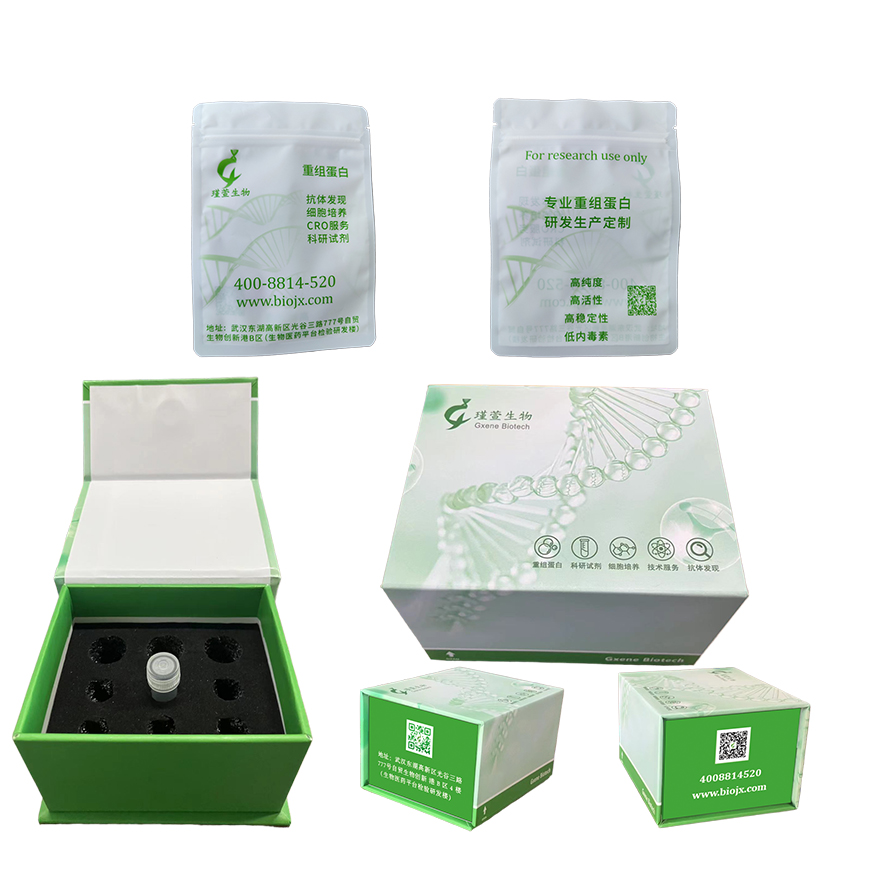描述
Recombinant Human Cathepsin S Protein is produced by HEK293 cells expression system. The target protein is expressed with sequence (Gln17-Ile331) of human Cathepsin S/CTSS (Accession #NP_004070.3) fused with an 8×His tag at the C-terminus.
内毒素
< 0.1 EU/μg of the protein by LAL method.
生物活性
Measured by its ability to cleave the fluorogenic peptide substrate, Mca-RPKPVE-Nval-WRK(Dnp)-NH2. The specific activity is >1390 pmol/min/μg.
制剂
Lyophilized from a 0.22 μm filtered solution of 50mM MES,100mM NaCl, pH6.5.Contact us for customized product form or formulation.
储存
Store the lyophilized protein at -20°C to -80 °C for long term.
After reconstitution, the protein solution is stable at -20 °C for 3 months, at 2-8 °C for up to 1 week.
复溶
Centrifuge the vial before opening. Reconstitute to a concentration of 0.1-0.5 mg/mL in sterile distilled water. Avoid votex or vigorously pipetting the protein. For long term storage, it is recommended to add a carrier protein or stablizer (e.g. 0.1% BSA, 5% HSA, 10% FBS or 5% Trehalose), and aliquot the reconstituted protein solution to minimize free-thaw cycles.
研究方向
组织蛋白酶 S 是半胱氨酸组织蛋白酶家族的成员。组织蛋白酶 S 具有特定作用,例如 MHC II 类抗原呈递,在恒定链的降解中发挥重要作用。组织蛋白酶 S 参与多种病理过程,包括关节炎、癌症和心血管疾病,它会被分泌并作用于细胞外底物。组织蛋白酶 S 具有独特的组织表达限制,并且在中性 pH 下更稳定。组织蛋白酶 S 在半胱氨酸组织蛋白酶家族中是独特的,因为其组织表达受到限制,与位于淋巴和脾脏中的抗原呈递细胞以及巨噬细胞等其他免疫细胞相关。组织蛋白酶 S 被认为是一种特别有效的半胱氨酸蛋白酶,可裂解弹性蛋白并产生具有生物活性的弹性蛋白肽,从而促进心血管炎症和钙化。组织蛋白酶 S 也由平滑肌细胞和巨噬细胞释放,作为连续递归反馈循环中炎症的全身反应。
背景信息
Cathepsin S (CTSS), one of the lysosomal proteinases, has many important physiological functions in the nervous system, especially in process of extracellular matrix degradation and endocellular antigen presentation. Cathepsin S is expressed in the lysosome of antigen presenting cells, primarily dendritic cells, B-cells and macrophages. Cathepsin S is most well known for its critical function in the proteolytic digestion of the invariant chain chaperone molecules, thus controlling antigen presentation to CD4+ T-cells by major histocompatibility complex (MHC) class II molecules or to NK1.1+ T-cells via CD1 molecules. Cathepsin S also appears to participate in direct processing of exogenous antigens for presentation by MHC class II to CD4+ T-cells, or in cross-presentation by MHC class I molecules to CD8+ T-cells. In addition, it has been implicated in the pathogenesis of several diseases such as Alzheimer’s disease and degenerative disorders associated with the cells of the mononuclear phagocytic system.

